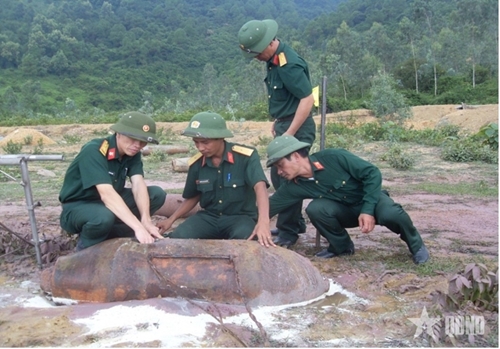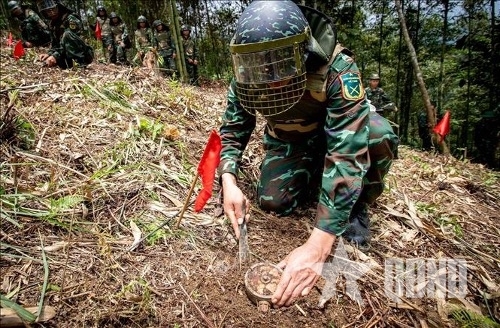    |
 |
|
Handling a bomb in Loc Ha district, Ha Tinh province |
Although the war ended half a century ago, many regions in Vietnam are still suffering from the deadly threat from bombs, mines and UXO left by war, causing immense loss for innocent civilians, negatively affecting the living environment, and hindering socio-economic development. With the goal of “For a Vietnam free from the impacts of bombs and mines,” the Engineering Corps has silently worked and risked their lives to revive lands that were once fierce battlefields.
Post-war landmine/UXO contamination - Pain and responsibility
Vietnam is one of the countries most severely and complexly affected by UXO contamination in the world. The consequences of UXO are said to continue to impact the country’s socio-economic development for many more years. The total amount of bombs, mines, ammunition used by the U.S. military during the war in Vietnam amounted to about 15.35 million tons. The amount of UXO in Vietnam is estimated to be about 800,000 tons, consisting of many different types scattered across all provinces and cities nationwide. All 63 provinces and cities in the country are affected by UXO contamination. UXO buried underground at varying depths and terrain poses a high level of toxicity and a constant danger that can detonate at any time, making it a constant threat to the people.
As of 2024, after nearly 15-year effort, Vietnam still has about 5.6 million hectares of land contaminated with UXO, accounting for 17.71% of the country’s total area. Since the South liberation in 1975, more than 40,000 people have been killed, and more than 60,000 people have been injured by UXO left over from the war.
In addition to that, the country is still suffering from the consequences of chemical contamination. According to data from the Vietnam Association for Victims of Agent Orange, from 1961 to 1971, the U.S. military sprayed about 80 million liters of toxic chemicals over Southern provinces of Vietnam, causing the most catastrophic consequences in mankind’s history with 4.8 million Vietnamese being exposed thereto, including millions of people suffering from heavy after-effects.
The investigation, survey, and clearance of UXO have been carried out across many provinces for years, but due to the heavy and complex contamination, as well as limited resources and equipment, the results have been insufficient in comparison to the scale and requirements of the task. According to the Vietnam Mine Action Center (VNMAC), an average of 30,000 hectares of land is cleared annually.
Therefore, the Party, State, and military determine clearing UXO an important political task, and the Engineering Corps has been entrusted by the Party, State, and military as the core force to implement the mission.
A silent battle
Since the war ended, the Engineering Corps has quietly worked to clear UXO to revive lands devastated by bombs. This is a noble yet incredibly difficult and dangerous task and is considered a battle in peacetime where engineering troops face the line between life and death everyday.
Now Vietnam is on a path of development, with many roads being built and new projects constructed on land and rivers that were once ravaged by bombs. Before the construction of major national projects such as the North-South expressway, border patrol route, Long Thanh Airport, and the Sao Vang - Dai Nguyet oil pipeline, the engineering troops must quietly search each meter of land to ensure absolute safety for the construction site.
In the northern border provinces, there remains tens of thousands of hectares of land contaminated. However, the task of clearing UXO to assist in the search for and repatriation of fallen soldiers' remains is arduous, since they are hidden in difficult-to-reach areas, beneath vegetation, mud, or deep within stream beds. The engineering units have mobilized hundreds of thousands of man-days to search, collect, sort, and safely dispose bombs, mines, and UXO, ensuring the safety of local communities.
    |
 |
|
Engineering troops detecting and handling UXO in Minh Tan commune, Vi Xuyen district |
There is probably no task as harsh for soldiers as bomb and mine clearance. The signal from detection devices is also a signal that the engineering troops are entering a life-and-death moment. On November 12, 2020, while carrying out a mine clearance mission to assist in the search and repatriation of fallen soldiers' remains in Thanh Thuy commune, Vi Xuyen district, Ha Giang province, an shell exploded, resulting in the death of one soldier and injuring another.
Sometimes, the detection signals come from bomb shrapnel or steel, but with their high responsibility, the engineering soldiers carefully and diligently dig, searching every inch of soil or diving into ponds, lakes, and rivers dozens of times. They are all aware that missing a signal could lead to injury for those who come after. Some bombs and mines are buried deep under mud, riverbeds, or along the coast up to 1.5 meters deep, making excavation extremely difficult. Specialized equipment is required, and soldiers must possess strong physical endurance to dive and extract ordnance.
In spite of facing difficulties and dangers, engineering troops are all determined to fulfill the mission. It is the safety of border markers, peace of the people, the image of lush forests and fields, and villages, schools, and new infrastructure rising on the barren lands have motivated them to brave difficulties and dangers to complete the assigned tasks.
Translated by Tran Hoai